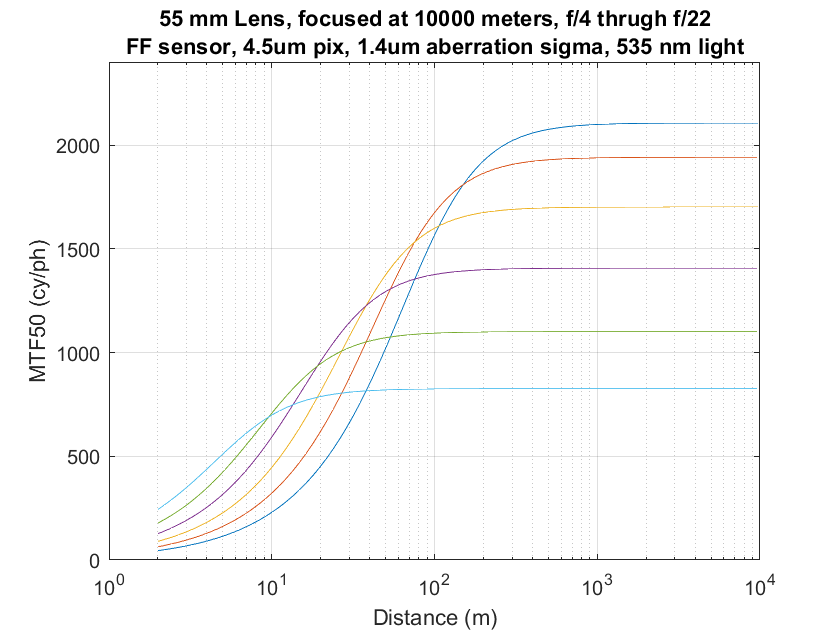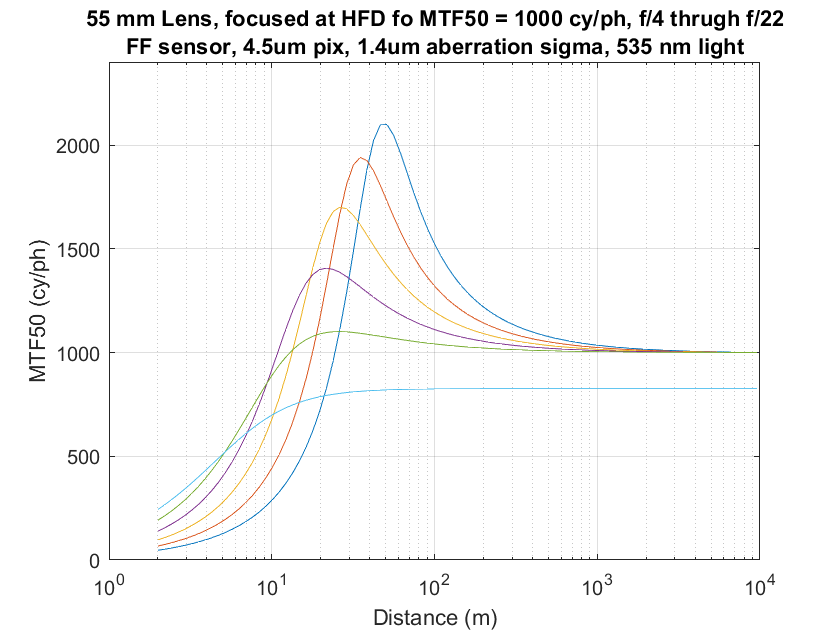This is a continuation of a report on new ways to look at depth of field. The series starts here:
When I made this post, I said that the story of exactly how the curves were generated was to complicated to be included. I will now fill in that gap.
The road to the combined absolute MTF50 diffraction/defocusing/aberrations/sensor sampling hyperfocal distance curve (HFD) starts out, as the relative HFD case, with these curves for our very good 55 mm lens focused at infinity:
The first thing I did was tell the computer to find, for each f-stop and many absolute MTF50 values between 400 and 2000 cycles/picture height (cy/ph), the object distances (the horizontal axis) on the curves where they crossed the desired MTF50 value. I then plotted the values thus found as the vertical axis against the target MTF50 values on the horizontal axis.
If you look at both sets of curves, you can see how this works. Let’s take 2000 cy.ph as a target. Looking at the top set of curves, we can see that we can only get that at f/4, and that the HFD is maybe 200 meters. Looking at the bottom set of curves, we can see that if we move upwards from the point on the horizontal axis marked 2000, we encounter only one curve, the f/4 one, and we meet it at about 150 meters on the vertical axis.
So there’s only one way to get to 2000 cy/ph, and that’s f/4, and we take whatever HFD we get.
Moving all the way to the left side of the graph, we can start at 400 cy/ph and go upward. It turns out that we can cross all the plotted lines in that case, meaning that all the plotted f-stops can deliver 400 cy/ph. But only the first line we cross, the f/22 line, can deliver that resolution at the least HFD, so that’s the HFD and aperture we should choose if we’re satisfied with 400 cy/ph and want the deepest possible DOF.
It’s interesting to see what the resolution looks like as a function of object distance if we focus the lens at the HFDs that correspond to one MTF50 value. Here’s a set of curves for 1000 cy/ph:
You can see that each of the f-stops has the same MTF50 at infinity and half the focused distance, but the peak sharpness is a function of the f-stop chosen. The reason there’s no peak to the lowest curve is that it corresponds to f/22, which can’t reach 1000 cy/ph at any focus setting, and thus is focused at infinity.
It’s clear that this approach throws away maximum sharpness, squandering it on a part of the picture not chosen by the photographer, in exchange for integrated control of minimum acceptable sharpness. TANSTAAFL.
If we’re looking for 1400 cy/ph, here’s what things look like:
Now both f/16 and f/22 have dropped out of the race.
At 1600 cy/ph:
f/11 through f/22 are not contenders.





Just a small correction, when you write ‘150 meters’, I think it should read ‘250 meters’.
Yes, you’re right. Let’s call it 200. I made the change. Thanks, and thanks for you pointer to the short Merklinger article.
Jim